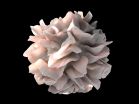(Press-News.org) PISCATAWAY, N.J. (March 18, 2015) - New research published by Rutgers University chemists has documented significant progress confronting one of the main challenges inhibiting widespread utilization of sustainable power: Creating a cost-effective process to store energy so it can be used later.
"We have developed a compound, Ni5P4 (nickel-5 phosphide-4), that has the potential to replace platinum in two types of electrochemical cells: electrolyzers that make hydrogen by splitting water through hydrogen evolution reaction (HER) powered by electrical energy, and fuel cells that make electricity from combining hydrogen and oxygen," said Rutgers Chemistry Professor Charles Dismukes. "Platinum is the benchmark material for both devices as it has the best conversion efficiency. However, while platinum may be acceptable for making jewelry and low volume specialty applications, it is too expensive for large-scale applications such as energy storage and conversion. Our new HER catalyst, Ni5P4, has the strong potential to overcome this challenge."
Rutgers Chemistry Professor Martha Greenblatt, Dismukes and colleagues published their findings on the patent-pending technology in March edition of the Royal Society of Chemistry journal, Energy & Environmental Science.
"Scientists have been working for years to develop low-cost replacements for platinum and other noble metals used in these devices," Greenblatt said. "Ni5P4 is the most promising new material presently available that combines both the energy conversion efficiency of noble metals, yet is much more affordable based on the high natural abundance of its elements - over a million times greater than platinum."
The researchers believe that Ni5P4 should lower the material costs of both electrolyzers and fuel cells, while maintaining the efficiencies of these technologies for electrical conversion. "These devices are two key technological advances that could open the door to renewable fuels produced from sustainable feedstocks - water and sunlight," Dismukes said.
The next step for the research is to test the operating stability and efficiency of the compound over extended time periods in commercial electrolyzers and fuel cells. As these devices have different requirements for operation, independent tests for both will be needed. Rutgers has partnered with Proton OnSite of Wallingford, Conn., a commercial manufacturer of electrolyzers, to test Ni5P4 as an appropriate HER catalyst.
To achieve the overall water splitting process, the HER catalyst cathode will be combined with an oxygen-evolving (OER) catalyst anode. The Rutgers team has previously developed a noble-metal-free OER catalyst - LiCoO2 (lithium cobalt oxide) - that has shown promising performance in preliminary tests at Proton OnSite.
"If used together, these catalysts could eliminate the need for expensive noble metal based electrode materials," Greenblatt said.
Funding for the Ni5P4 research was provided by the Air Force Office of Scientific Research, NATCO Pharma Ltd. and Rutgers, while the OER research is now being funding by the Department of Energy Office of Energy Efficiency and Renewable Energy.
In related work, scientists from Rutgers and Proton OnSite are partnering with members of the Solar Fuels Institute (SOFI) of Telluride, Colo. on a demonstration project that seeks to build a solar-powered mobile electrolyzer for making public demonstrations showing the production of a renewable liquid fuel using only sunlight, water and carbon dioxide as inputs.
Joining Professors Dismukes and Greenblatt as co-authors of the Energy & Environmental Science article were Postdoctoral researchers Drs. Anders Laursen, Mariana Whitaker, Maria Retuerto, and Tapati Sarkar, and undergraduate Kelly Patraju, all of Rutgers; Dr. Nan Yao of Princeton University; and Professor Kandalam Ramanujachary of Rowan University.
INFORMATION:
About Rutgers University Department of Chemistry & Chemical Biology
The Chemistry and Chemical Biology Department (CCB) at Rutgers, The State University of New Jersey, is a national leader in undergraduate and graduate education and scientific research. The National Science Foundation (NSF) has ranked Rutgers among the top ten universities nationally in funding for chemistry research and development over the past decade. Chemistry faculty members have obtained more than 250 patents and $170 million in venture capital over the past 12 years. Rutgers is currently constructing a signature Chemistry building, on the Busch campus. For more information, please visit http://chem.rutgers.edu/.
The number of people living with cystic fibrosis into adulthood in the UK is expected to increase dramatically - by as much as 80 per cent - by 2025, according to a Europe-wide survey, the UK end of which was led by Queen's University Belfast.
People living with cystic fibrosis have previously had low life expectancy, but improvements in treatments in the last three decades have led to an increase in survival with almost all children now living to around 40 years. In countries where reliable data exists, the average rise in the number of adults with CF is expected to be ...
A recent study published in the Journal of the American Academy of Child and Adolescent Psychiatry reports that following military parents' return from combat deployment, their children show increased visits for mental healthcare, physical injury, and child maltreatment consults, compared to children whose parents have not been deployed. The same types of healthcare visits were also found to be significantly higher for children of combat-injured parents.
Children of deployed parents are known to have increased mental healthcare needs, and be at increased risk for child ...
When cancer strikes, it may be possible for patients to fight back with their own defenses, using a strategy known as immunotherapy. According to a new study published in Nature, researchers have found a way to enhance the effects of this therapeutic approach in glioblastoma, a deadly type of brain cancer, and possibly improve patient outcomes. The research was funded by the National Institute of Neurological Disorders and Stroke (NINDS) as well as the National Cancer Institute (NCI), which are part of the National Institutes of Health.
"The promise of dendritic cell-based ...
Boulder, Colo., USA - Unaweep Canyon is a puzzling landscape -- the only canyon on Earth with two mouths. First formally documented by western explorers mapping the Colorado Territory in the 1800s, Unaweep Canyon has inspired numerous hypotheses for its origin. This new paper for Geosphere by Gerilyn S. Soreghan and colleagues brings together old and new geologic data of this region to further the hypothesis that Unaweep Canyon was formed in multiple stages.
The inner gorge originated ~300 million years ago, was buried, was then revealed about five million years ago when ...
Latinos are the largest ethnic minority group in the United States, and it's expected that by 2050 they will comprise almost 30 percent of the U.S. population. Yet they are also the most underserved by health care and health insurance providers.
Latinos' low rates of insurance coverage and poor access to health care strongly suggest a need for better outreach by health care providers and an improvement in insurance coverage. Although the implementation of the Affordable Care Act of 2010 seems to have helped (approximately 25 percent of those eligible for coverage under ...
Could our reaction to an image of an overweight or obese person affect how we perceive odor? A trio of researchers, including two from UCLA, says yes.
The researchers discovered that visual cues associated with overweight or obese people can influence one's sense of smell, and that the perceiver's body mass index matters, too. Participants with higher BMI tended to be more critical of heavier people, with higher-BMI participants giving scents a lower rating when scent samples were matched with an obese or overweight individual.
The findings, published online in the ...
COLLEGE STATION -- Researchers at Texas A&M AgriLife Research have developed a new technology to determine sensitivity or resistance to rabies virus.
"We were able to create a novel platform such that we could look at how pathogens, such as bacteria or virus or even drugs or radiation, interact with specific human genes," said lead researcher Dr. Deeann Wallis, AgriLife Research assistant professor of biochemistry and biophysics. "It allows us a new way to profile the genes involved in sensitivity or resistance to certain agents."
The rabies work is being reported in ...
SAVANNAH, Ga., March 19, 2015 - Bad news for relentless power-seekers the likes of Frank Underwood on House of Cards: Climbing the ladder of social status through aggressive, competitive striving might shorten your life as a result of increased vulnerability to cardiovascular disease. That's according to new research by psychologist Timothy W. Smith and colleagues at the University of Utah. And good news for successful types who are friendlier: Attaining higher social status as the result of prestige and freely given respect may have protective effects, the researchers ...
PORTLAND, Ore. - March 19, 2015 - A new in vitro (test tube) study, "Dietary functional benefits of Bartlett and Starkrimson pears for potential management of hyperglycemia, hypertension and ulcer bacteria Helicobacter pylori while supporting beneficial probiotic bacterial response," was published in the March issue of Food Research International.1
In a laboratory in vitro setting, Kalidas Shetty, PhD, currently a professor of plant science at North Dakota State University, and the research's lead author, Dr. Dipayan Sarkar, studied the compounds found in two pear varieties, ...
Researchers at the Max Delbrück Center for Molecular Medicine (MDC) Berlin-Buch and Charité - Universitätsmedizin Berlin, Campus Berlin-Buch, have succeeded in generating cells of the immune system to specifically target and destroy cancer cells. The research findings of Matthias Obenaus, Professor Thomas Blankenstein (MDC and Charité), Dr. Matthias Leisegang (MDC) and Professor Wolfgang Uckert (Humboldt-Universität zu Berlin and MDC) as well as Professor Dolores Schendel (Medigene AG, Planegg/Martinsried) have now been published in Nature Biotechnology ...




